Introduction
The Brother MFC-J4710DW colour multifunction printer that I am reviewing is based on a new paper-feed concept where the paper is fed through the machine by the long edge and marked across the long edge when the document is printed, which would be described as being “landscape orientation”. The key advantages of this design yield a relatively compact machine compared to most desktop inkjet printers which are much deeper as well as a quicker turnaround when the document is printed.
I am reviewing the MFC-J4710DW which is the top of the line model in this series and this has two paper trays as well as Wi-Fi networking. Lesser models like the MFC-J4510DW have a single paper tray as well as omitting the single-pass duplex automatic document feeder. The cheapest models like the MFC-J4410DW also have a slower print speed for those who don’t value the quick turnaround.
| Scan | Copy | Fax / |
Paper Trays | Connections | |
| Colour | Colour | Colour | Colour | 2 x A4 | USB 2.0 |
| Piezoelectric Ink-jet | 2400dpi | Optimised book copy, ID copy, duplex copy | Super G3 | Multi-purpose tray with A3 capability | Ethernet, 802.11g/n Wi-Fi |
| Auto-duplex | Single-pass duplex ADF | T.37 Internet fax, scan to email | IPv6 |
Prices
Printer
Recommended Retail Price: AUD$299
Inks
| Standard | High-Capacity | |||
| Price | Pages | Price | Pages | |
| Black | AUD$30 | 600 | AUD$37 | 1200 |
| Cyan | AUD$24 | 600 | AUD$34 | 1200 |
| Magenta | AUD$24 | 600 | AUD$34 | 1200 |
| Yellow | AUD$24 | 600 | AUD$34 | 1200 |
The printer itself
As I mentioned before, the Brother MFC-J4710DW prints along the long edge of the A4 sheet of paper. There are two paper trays so you can use different media types or sizes like A4 and A5 or letterhead and regular paper.
Installation and setup
Like with the previously reviewed Brother MFC-J6910DW, this printer uses a cavity in the top of the machine under the scanner bed for connecting USB or Ethernet cables. This is different to the common practice of having these connections on the back of the printer and may impede in having them easily accessible if you wish to move the machine between different locations. Of course, the power and telephone connections are kept easily accessible.
For network connectivity, this printer supports Ethernet and 802.11g/n Wi-Fi connectivity. It also is ready for IPv6 networks which are becoming the norm for business networks and will become the norm with the next-generation broadband Internet.
Like the other inkjet multifunction printers that Brother offers and the newer HP OfficeJet small-business Inkjet printers, this printer has you load the cartridges via the front of the machine. This is a method which I applaud because you don’t have to lift a lid to change the ink cartridges when you run out of ink and this printer doesn’t require much effort to remove or insert the cartridges. It didn’t require much effort to load the cartridges in the printer which would work well with its useability.
Walk-up functions – can be started from printer’s control surface
I have done a few copying jobs with this printer and have found that it could benefit from a few improvements when it comes to locating the document on the glass platen for copying.
Here, you have to have the markings for where you locate the documents for scanning and copying in a contrasting colour so you can find where to position that document.
As well, the automatic document feeder can appear to be confusing for the unitiatied especially when it comes to locating the document. Here, you have to make sure that it is between the light-grey document guides and this issue may also be of concern with printers that use ultra-compact automatic document feeders. As well, the pages that are finished with are appear to be on top of the pages that are yet to be scanned which can be very confusing when you wish to remove pages that are finished with and / or add more pages to the job during a scan or copy of a large document.
It has copying features like optimised book copy, “copy to A3” and ID copy which are features I would start to expect from most copying devices. The optimised book copy feature worked very well when I was doing some copying of recipes from some cookbooks for someone who was cooking these recipes at another kitchen. It was also very accurate when it came to copying the documents.
The Brother MFC-J4710DW supports Super G3 colour faxing over the regular telephone line and has the expected capabilities of a business fax machine. As well, you can download a free add-on from Brother’s Website to enable it to become an endpoint for T.37 “fax-via-email” services. This includes the ability to forward faxes received via email to regular fax machines that don’t support this technology using the phone line.
There is of course memory card slots and a USB port to facilitate “walk-up” printing of images and PDF documents from USB thumbdrives or memory cards. This also has the ability to print from PictBridge-capable cameras, but can work as a charging point for your smartphone, tablet or other gadgets even when the printer is in a quiescent standby mode. These are hidden behind a black drop-down flap on the front of the printer.
Web-based services
Brother supports integration with the popular Web-hosted storage, photo-sharing and social-networking services with this printer. This setup operates in a manner which I like and I was pleased with it after I tested it with my Facebook account to print 2 images from an album of mine.
Here, you don’t have to enter your login parameters in to the device, which avoids using a small touchscreen keyboard for this effort. Instead, you use the Brother Web Connect page to enrol your printer with the cloud storage, social network or other service you have your account with. Once you log in to your service, a user interface will come up to ask you whether to allow this software and service to have access to your resources and those resources you are entitled to have access to. Then, if you give the go-ahead, you are given a temporary registration number which you key in to your printer on its control surface.
Then, at the printer, you select “Web” then select the service you want to use and touch the “Register/Delete” option. This is where you key in this registration number and give the account a known name and have the option to set a PIN to prevent unauthorised access to the account. With the photo-sharing services and the social networks, you have the ability to print out the pictures or download them to removeable media that is plugged in to the printer. As well, you can scan or upload the pictures to the photo sharing service or social network.
If you use Dropbox, Evernote or a similar service, you also have the ability to turn out hard copy of PDF documents and scan hard copy documents to these services as PDF files. Personally, I would like to see the ability to upload PDFs from removeable media that is plugged in to the printer.
It is one of a few method that I would like to see for linking users’ accounts on Web-based services with devices like printers or consumer-electronics devices in order to benefit from these services. Here, it exploits the reduced user interfaces that these devices typically have such as a numeric keypad or a D-pad by avoiding the need to “pick” letters on a virtual keyboard or be nimble with the numeric keypad for text entry when you sign in to Facebook, Picasa or Dropbox from one of these devices.
As for loading images from a Facebook album, it can take a bit of time to show up the pictures from that album but the pictures were gradually loaded one by one. But once you chose the pictures to print, the print duration was very similar to what I would expect for turning out photos.
Working with mobile devices
As for working with a mobile device, the Brother MFC-J4710DW printer worked properly with the iPrint&Scan mobile app on my Android phone. This was more so when it came to turning out photos or PDFs held on that phone.
There is also native support for Apple’s AirPrint technology as well as Google Cloud Print technology which can go a long way with printing from the iOS and Android devices.
Computer functions
Although I use the latest driver software from Brother’s Web site rather than what was on the CD in the box. I had found that the software had loaded very quickly without noticeable issues on my Windows 8 computer.
The ControlCenter 4 desktop-scan software could benefit from a “continuous scan” option available not as a custom setting but as an option immediately selectable from the scanning screen. HP’s desktop scanning software has the option to add pages offered as a default option and you click “Finish” to have the file completed and saved at the end of a scan job. Here, this would come in handy when you manually scan multi-page documents using the scanner platen due to factors like odd paper sizes, bound material or fragile documents; or pass a large multi-sheet document through the automatic document feeder.
The scanning procedure was very quick and accurate and performed properly even when I was scanning some very old fragile documents to PDF files.
As for the print driver, this software didn’t show any unnecessary dialogue boxes or pop-up messages during the printing procedure.
Print quality and reliability observations
A 30-page printout on one side of the paper had yielded a quick reliable turnout but the colour may not appear to be as accurate as it should be for the printout. The high-speed turnout was brought on by the ability to work along the long edge of the paper.
A test that I do with printers that have auto-duplex facilities is to have the printer print a “download-to-print” door-hanger campaign document master on both sides of the paper using this function. Here, I look for any shift between the front and the back of the document so as to determine whether the duplexer mechanism is causing any unwanted shifting between the front and back of the document which may concern those of us who are using this function as part of creating odd-shaped desktop publishing projects like bookmarks, luggage tags or door hangers. I had noticed a very slight shift between the back of the document is slightly forward on the long edge compared to the front when I completed this test on this Brother printer.
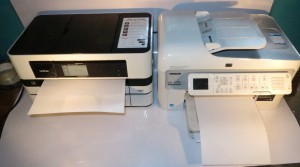
Landscape document output on the Brother printer compared to the portrait document output on an orthodox multifunction printer
The Brother MFC-J4710DW also had passed the reliable printing test where I had it print a 90-page PDF using auto-duplex. This was important because a lot of people may think that the “long-edge” printing may be too “cutting-edge” to be considered reliable in a first-generation implementation of this technology. It has successfully completed the test without causing any worries.
When I printed out the test photos on the glossy paper, I noticed a strong yellow overtone on the pictures which was noticeable on the white parts of the image. As well, the flesh tones tended to become a bit more red. There also wasn’t much of the sharpness and definition in the images. I had done this test using the “best” settings for the printer driver rather than the normal settings and it may be a driver-specific issue. When it came to turning out images from the Internet using the printer’s control panel, there wasn’t much of that yellow overtone.
I had to use the manual bypass slot at the back of the printer to load the glossy paper sheets and this required me to load each sheet one at a time. Here, I was able to see the “long-edge” printing feature in action when it came to handling the pictures.
The big question that is likely to be asked about the Brother MFC-J4710DW and its peers is whether the “sideways print” / “long-edge print” / landscape print technology is too “cutting-edge” for reliable operation? Personoally, I had found this to be reliable for a first-generation implementation of this setup.
Limitations and Points Of Improvement
The Brother MFC-J4710DW could benefit from a few extra features and these may be issued with subsequent-generations of this print setup.
One feature that would come a long way would be to allow more than one sheet of paper to be in the manual feed slot for situations where you may be printing many multi-page documents on A3 or special media.
It could also benefit from a document rest that automatically extends and retracts in a similar way to what happens with the HP Envy printers. This can keep the printer having that compact shape that it is known for/
The on-device software could benefit from a few useability improvements. For example, the Web Connect functionality could allow for searching or sorting “other users” on a social network when you are hunting down pictures to print from a “friend’s” album.
The other issue that is of concern not just with this machine but with all of the network-enabled multi-function printers that have fax ability is to support Internet-based time synchronisation. Here, you could just then determine what time zone you are in and the printer sets its clock for you automatically like what happens with most desktop and mobile computer operating systems. Similarly, a lot of these printers could benefit from increased memory or flash memory in order to allow for efficient copy, fax and “walk-up” printing functionality as well as being able to maintain its own network print queue.
Conclusion and Placement Notes
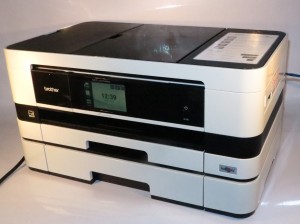 I would recommend that the Brother MFC-J4710DW or its peers be considered as an option when you are considering a general-purpose desktop multifunction printer for the small business, professional’s office or a home office. This is especially where space is at a premium or a large desktop multifunction printer doesn’t look the part in your office space’s aesthetics.
I would recommend that the Brother MFC-J4710DW or its peers be considered as an option when you are considering a general-purpose desktop multifunction printer for the small business, professional’s office or a home office. This is especially where space is at a premium or a large desktop multifunction printer doesn’t look the part in your office space’s aesthetics.
The cheaper models may work well if you are on a budget and don’t place value on printing speed or simply have a high-end laser printer serving your high-speed printing needs.

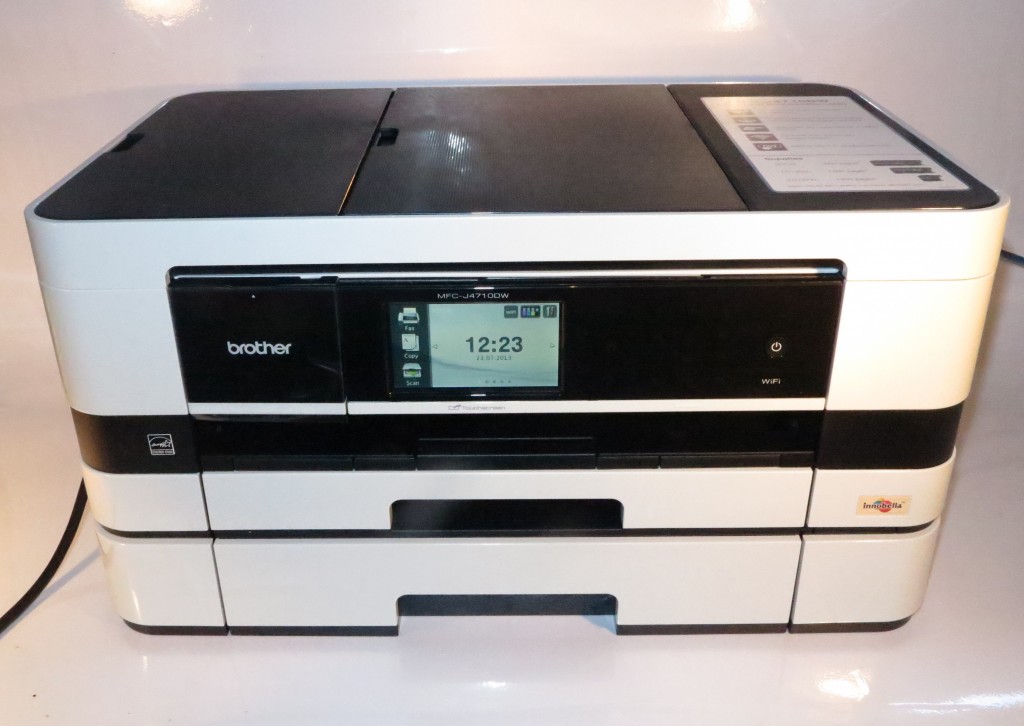
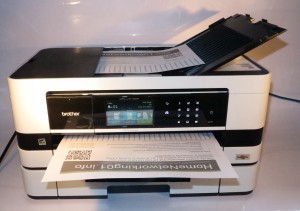
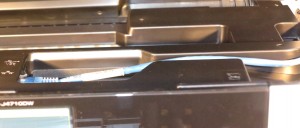
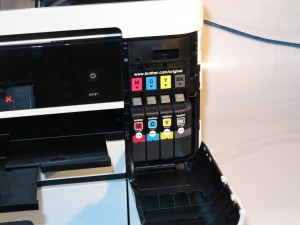

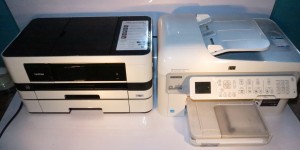
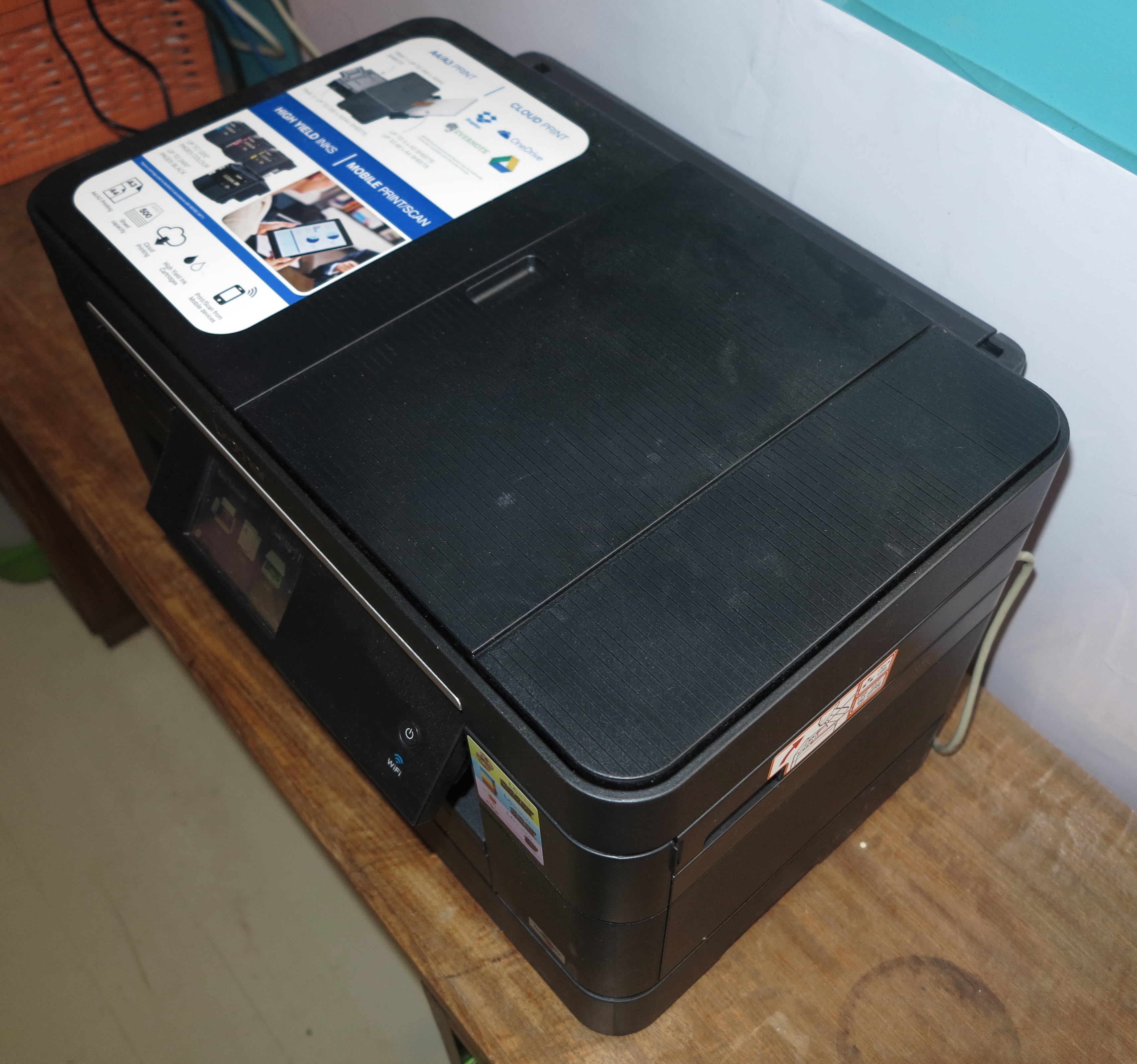
Brother MFC-J4710DW is usually virtually identical for the Brother MFC-J4610DW in many other ways
The Brother MFC-J4710DW has, as an extra feature compared to the MFC-J4610DW, the ability to scan both sides of a page at once when a document is passed through its automatic document feeder. As well, the MFC-J4610DW may not be available in all markets.